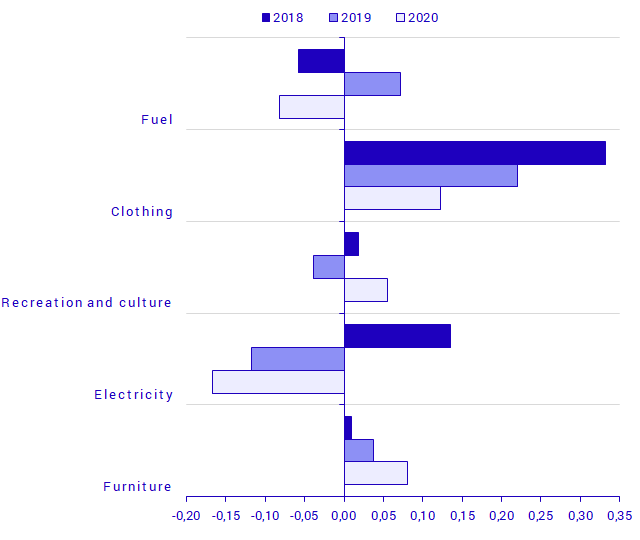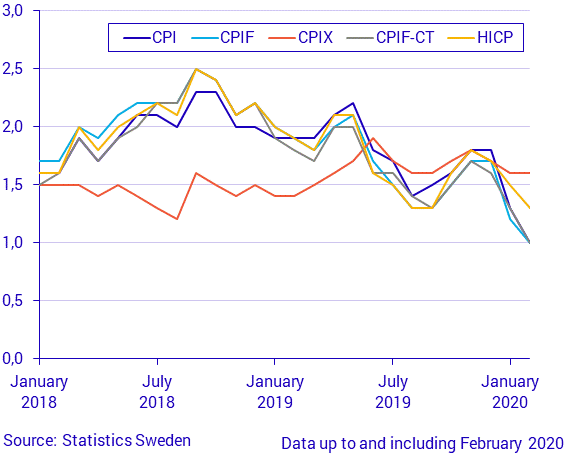Consumer Price Index (CPI), February 2020
Inflation rate according to CPIF was 1.0 percent in February
Statistical news from Statistics Sweden 2020-03-12 9.30
The inflation rate according to the CPIF (Consumer Price Index with fixed interest rate) was 1.0 percent in February 2020, down from 1.2 percent in January. The change on a monthly basis between January and February was 0.5 percent.
In brief
| Index Numbers | Monthly changes, percent | Annual changes, percent | |
|---|---|---|---|
| CPI (1980=100) | 334.47 | 0.5 | 1.0 |
| CPIF (1987=100) | 218.69 | 0.5 | 1.0 |
| CPIF-XE (1987=100) | 206.50 | 0.8 | 1.6 |
- Lower electricity prices continued to bring down the inflation.
- Seasonally normal higher prices on clothing affected the CPIF significantly less in February than in recent years.
- The inflation rate according to the CPIF-XE, that is, the CPIF excluding energy was 1.6 percent in February and thus, remained unchanged from January 2020.
Food, electricity and fuel affected the CPIF in February
The CPIF increased by 0.5 percent between January and February. In the corresponding period a year ago, the CPIF increased by 0.7 percent. The main contribution to the monthly rate came from higher prices on food and clothing. This upward contribution was offset mainly by lower prices on electricity and fuel.
The table below shows changes on a monthly basis and effects on the CPIF based on the goods and services that had the largest effect on the CPIF in February 2020. The results are reported per COICOP category; COICOP refers to the United Nations classification of household consumption expenditure.
| NamnENG | Monthly changes, percent | Monthly effect on the CPIF, percentage points |
|---|---|---|
| Food (01.1) | 1.2 | 0.2 |
| Clothing (03.1) | 3.6 | 0.1 |
| Electricity (04.5.1) | ‑4.4 | ‑0.2 |
| Furniture (05.1) | 3.4 | 0.1 |
| Fuel (07.2.2) | ‑3.1 | ‑0.1 |
| Package holidays (09.6) | 8.4 | 0.1 |

Seasonal patterns and temporary price changes
Price changes for goods and services may be seasonal or temporary. The figure above shows effects on a monthly basis for the goods and services that differ most compared with the corresponding month a year ago.
Clothing prices rose in February, which is normal for the season after the winter sales. However, the contribution to the CPIF was not as large as in previous years, which in part is due to a somewhat smaller increase in prices and in part due to a lower weight for clothing in 2020. Electricity prices fell in February, as in the previous year. Fuel prices rose in February 2019, while in February 2020, prices fell.
Contributions to inflation rate in February
The inflation rate according to the CPIF, that is, the change in the CPIF over the past 12-month period, was 1.0 percent in February 2020. This is a decrease compared with 1.2 percent in January.
The largest contribution to the inflation rate in February 2020 came from higher prices on transport and food. Price decreases on electricity and telecommunications equipment offset this increase.
| Yearly change, percent | Yearly change effect, percentage points | |
|---|---|---|
| Food (01.1) | 2.3 | 0.3 |
| Electricity (04.5.1) | ‑13.1 | ‑0.6 |
| Rented and housing co-operative dwellings: rent incl. heating (04.S) | 1.5 | 0.2 |
| Housing (4.x) | 2.6 | 0.2 |
| Transport (07) | 3.7 | 0.5 |
| Telephone equipment (08.2) | ‑16.2 | ‑0.2 |
| Restaurants (11.1) | 3.1 | 0.2 |
Other measures of inflation
Statistics Sweden produces different inflation measures for different purposes. The CPIF is the Riksbank’s target variable, while the CPI is the measure used for purposes of compensation.

Definitions and explanations
The CPIF shows the same price trend as the CPI, but without the direct effects of a changed monetary policy. The CPIF is the Riksbank’s target variable for the inflation target.
The CPIF excluding energy (CPIF-XE) and the CPIF with constant tax (CPIF-CT) are two other measures of inflation produced by Statistics Sweden on behalf of the Riksbank. In the CPIF-XE, energy products are excluded from the CPIF, while in the CPIF-CT the taxes and subsidies associated with the products in the CPIF are kept constant.
The HICP (Harmonised Index of Consumer Prices) is produced by all EU Member States. This measure has a somewhat smaller coverage than the CPI and the CPIF, mainly due to the fact that parts of households’ housing costs are omitted.
Next publishing will be
2020-04-15 at 9:30.
Statistical Database
More information is available in the Statistical Database
Feel free to use the facts from this statistical news but remember to state Source: Statistics Sweden.
